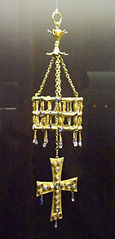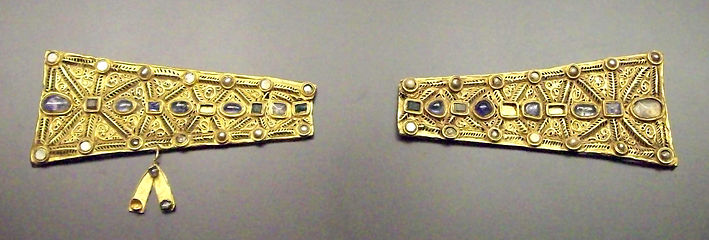Treasure of Guarrazar
The Treasure of Guarrazar is a treasure of Visigothic goldwork made up of crowns and crosses that various kings of the Visigothic kingdom of Toledo offered in their day as ex-voto. It was found between 1858 and 1861 in the archaeological site called Huerta de Guarrazar, located in the town of Guadamur, very close to Toledo. The pieces are distributed among the Musée Cluny in Paris, the Royal Palace Armory and the Archaeological Museum National, both in Madrid.
Composition
Among all the pieces found, the most valuable are the votive crowns of the kings Recesvinto and Suintila; the latter was stolen in 1921 and has not yet been recovered. Both are made of gold, set mainly with pearls and cabochon-cut sapphires. There are also other poorer and smaller crowns and votive crosses. Belts were also found, now missing.
The tradition of goldsmith workshops in the Iberian Peninsula dates back to prehistory, but that of the Visigothic period is closely linked to Byzantine goldsmithing. In addition to setting, the technique of embedding stones in alveoli is used, which was preferred by the Germanic peoples; It is the technique used in the letters of the crowns, which are executed with alveoli of gold where carved garnets have been embedded in the hole. In the votive crown of Recesvinto, these hanging letters say the following in Latin: RECCESVINTVS REX OFFERET (King Recesvinto offered her). The embossed decorations on the blades of the crosses are of the Germanic type, but the shape of the votive crowns is totally Byzantine. The treasure crowns are of the votive type, not suitable to be worn as a headdress.
The presence of Byzantine jewels in the Visigothic treasuries was so abundant, according to literary testimonies, that in the churches of Mérida "there were jewels to fill several carts" (Lives of the Emeritense Fathers). Arab sources testify that when the Muslims entered Toledo, they found in the cathedral a series of votive crowns that the Visigothic kings had donated, and that many were melted down at that time to take advantage of the noble metals. The jewels in the church of Toledo and those in the royal treasury were the cause of envy and serious disputes among the Arab conquerors. A large part of these crowns and crosses must have been hidden by the Visigothic clergy, as happened with those that were in the nearby monastery of Santa María de Sorbaces.
Story of discovery
Part of the Guarrazar treasure was found by chance. In 1858 there were torrential rains that caused the collapse of the land where the church of the monastery of Santa María de Sorbaces was located, in Guadamur, a town 11 km from Toledo. It had been hidden in two "boxes" covered with Roman concrete, which had a depth of 1.60 m and left a square hole of 0.75 m, next to the tomb of a priest named Crispinus or Crispin, who curiously preserves a tombstone from the Visigothic period. Each of the deposits had a different finder. The first was Francisco Morales, a forty-year-old farmer, who dismantled many of the jewels and sold fragments and components on frequent trips to Toledo silversmiths. The Frenchman A. Herouart, a professor in Toledo and a friend of Morales, acquired the jewels that Morales still had in his possession and seized the land where the treasure appeared. Herouart sold the jewels to a diamond cutter, José Navarro, who recomposed some crowns, rescuing what the silversmiths from Toledo had not yet melted down. In 1859 Navarro traveled to Paris and negotiated the sale of the eight crowns and six pending crosses to the French Government. The sale was published in several French magazines. The rapid echo of the news in Spain unleashed the intervention of the Provincial Commission of Monuments, first, and that of the Government of the nation, which began the rapid diplomatic claim, a judicial investigation and archaeological excavations in the place.
The second batch also suffered continued declines due to sales by its discoverer, Domingo de la Cruz. In March 1861, faced with the difficulty of disposing of his jewels, he opted to give Queen Elizabeth II the two jewels he had left, and among them the crown of Suintila.
Today, after numerous vicissitudes, the remaining jewels of the Guarrazar Treasure are kept in three different institutions.
The Cluny Museum in Paris keeps three crowns, that of Sonnica, with a hanging cross, another decorated with arches and the third with a balustraded grid, a hanging cross, the R hanging from the crown of Recesvinto found in Spain, which began with his name, two other pendants and four suspension elements.
In the National Archaeological Museum of Madrid, the jewels returned by France in 1941 are preserved: they are the six crowns, that of Recesvinto, two of gold leaf with embossed decoration and three of balustraded reticle, together with four hanging crosses; In addition, there is a set of loose elements, coming from the National Library's Antiquities Cabinet, when the museum was established: the arm of the great cross, the hanging Alfa and other fragments and loose stones. Actually, the so-called "arm" They are two gold plates 22 cm wide by 10.5 cm maximum height at one end and 5 cm at the other. They were part of a cross kick. The plates would cover a wooden soul, but after the comings and goings of the silversmiths of Toledo, etc., the cross was destroyed and only one arm of it had survived.
Finally, in the Royal Palace of Madrid there are still, from the second batch, the crown of Abbot Teodosio, the cross of Bishop Lucecio, an engraved emerald, as well as detached stones and pendants. In October 1936 several fragments and pieces disappeared. The Crown of Suintila was stolen from the Royal Armory of the Royal Palace on the morning of April 4, 1921 and its traces could never be traced. A piece of trellis wreath also disappeared. Little was reported about the theft, only La Época made a more extensive publication with engravings, to serve as a guide in the search for what was stolen. Apparently the perpetrators of the robbery were located, but not the stolen objects.
The gemological study by Juan S. Cozar and Cristina Sapalski revealed that the Guarrazar Treasure contains 243 blue sapphires, whose characteristics make them come from ancient Ceylon, today Sri Lanka, 3 blue cordierites or iolites, 14 emeralds, 1 aquamarine, 2 adularias or moonstones, 21 amethyst quartz, 9 hyaline quartz, 6 bluish chalcedony, 169 pearls, 154 pieces of mother-of-pearl, 56 green artificial glass, 26 blue artificial glass, 2 orange-brown, 26 of indefinite color, 1 red and many tiny pieces of pyrope-almandine garnet.
Contenido relacionado
Triskaidekaphobia
Port Royal
Cryptanalysis







